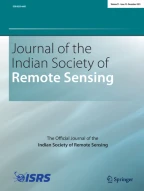Application of remote sensing and GIS in watershed characterization and management

This is a preview of subscription content, log in via an institution to check access.
Access this article
Subscribe and save
Springer+ Basic
€32.70 /Month
- Get 10 units per month
- Download Article/Chapter or eBook
- 1 Unit = 1 Article or 1 Chapter
- Cancel anytime
Buy Now
Price includes VAT (France)
Instant access to the full article PDF.
Rent this article via DeepDyve
References
- AIS & LUS (1971).‘Soil Survey Manual’, IARI, New Delhi. Google Scholar
- Bodhankar, R.M., Srivastava, R., Saxena, R.K. and Jagdish Prasad (2002). Integrated approach of RS and GIS in characterization and evaluation of land resources for watershed management- A case study.In (Dhyaniet al.) Resource Conservation and Watershed Management: Technology Options and Future Strategies. IASWC, Dehradun, India, 435p. Google Scholar
- IMSD (1995). Technical Guidelines. National Remote Sensing Agency, Department of Space, Govt. of India, Hyderabad. Google Scholar
- Jagdish Prasad, Chary, GR. and Gajbhiye, K.S. (1995). Custard Apple- a boon to Vidarbha.Intensive Agriculture,XXXIII(5–6): 17–20. Google Scholar
- Jagdish Prasad (1996). Managing Nagpur Mandarin in shallow soils.Indian Horticulture,41(1): 25–26. Google Scholar
- Kasturirangan, K., Aravamudan, R., Deekshatulu, B.L., Joseph, George and Chandrasekhar, M.G (1996). Indian remote sensing satellite IRS 1C. The beginning of new era.Curr. Sci.,70: 495–500. Google Scholar
- Klingebiel, A.A. and Montgomery, P.H. (1961). Land capability classification. Agric. Handbook210, SCS, USDA, Washington, DC. Google Scholar
- NBSS & LUP (1994). Soil-site suitability criteria for different crops.In: Proc. National meet on soil-site suitability criteria for different crops, Feb. 7-8,1994.
- Saxena, R.K., Verma, K.S., Chary, GR., Srivastava, R. and Barthwal, A.K. (2000). IRS-1C Data application in watershed characterization and management.Int. J. Remote Sensing,21 (17): 3197–3208. ArticleGoogle Scholar
- Sharma, J.P., Saxena, R.K., Nagaraju, M.S.S., Srivastava, R., Jagdish Prasad, Sunil Kumar and Barthwal, A.K. (2004). Utilization of remote sensing data for characterization of land resources of Khursapar village, Nagpur district, Maharashtra. Abstracts, 24 th ISRS Annual Convention and National Symposium, held at Jaipur from Nov. 3-5, 2004, pp. 198–199.
- Soil Survey Division Staff (2000).’SoilSurvey Manual’, (Indian Print) Handbook No 18, USDA, Washington, DC. Google Scholar
- Soil Survey Staff (1999). ‘Keys to Soil Taxonomy’, Eighth edition, USDA, Washington, D.C. Google Scholar
- Srivastava, R. and Saxena, R.K. (2004). Technique of large- scale soil mapping in basaltic terrain using satellite remote sensing data.Int. J. Remote Sensing,25(4): 679–688. ArticleGoogle Scholar
- Suresh, M., Sudhakar, S., Tiwari, K.N. and Chowdary, V.M. (2004). Prioritization of watersheds using morphometric parameters and assessment of surface water potential using remote sensing.J. Indian Soc. Remote Sensing,32(3): 249–259. ArticleGoogle Scholar
- Sys, C, Van Ranst, E. and Debaveye, J. (1991).‘Land evaluation’, Part 1 & 2, Agricultural publ. No.7, Brussels, Belgium. Google Scholar
- Yadav, S.S., Jagdish Prasad and Gaikawad, S.T. (1999). Soil and site characteristics in relation to yield of cotton in Vidarbha region of Maharashtra.J. of the Indian Soc. of Soil Science,47(2): 385–388. Google Scholar
About this article
Cite this article
Application of remote sensing and GIS in watershed characterization and management. J Indian Soc Remote Sens 33, 239–244 (2005). https://doi.org/10.1007/BF02990041
- Received : 01 May 2004
- Accepted : 14 February 2005
- Issue Date : June 2005
- DOI : https://doi.org/10.1007/BF02990041
Share this article
Anyone you share the following link with will be able to read this content:
Get shareable link
Sorry, a shareable link is not currently available for this article.
Copy to clipboard
Provided by the Springer Nature SharedIt content-sharing initiative
Keywords
- Sorghum
- Remote Sensing
- Land Irrigability
- Land Capability
- Physiographic Unit

